Kids Show Wil Pick Yoi Up Again
What'due south then fascinating about weird children's Telly shows?
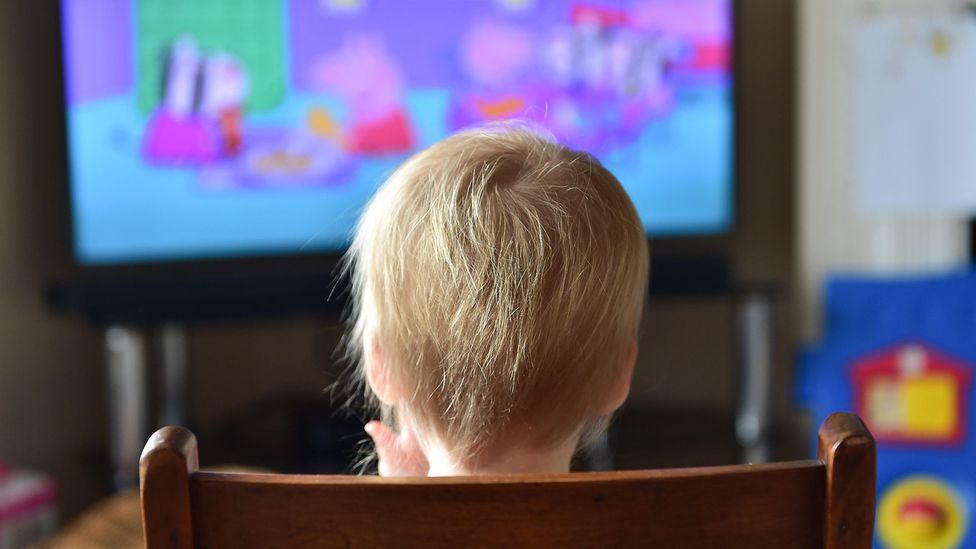
They depict hypnotic worlds filled with acidic colours and baffling plot lines, but children's television can requite u.s.a. surprising insights into how our brains develop every bit nosotros grow upwards.
P
Pepi Nana stirs, and sits up in bed.
"Tiddle toddle, tiddle toddle," she says, flapping her artillery, and blinking a pair of enormous round eyes. She walks over to the desk, sits down, and, using the oversized pencil in her front pocket, scribbles a letter to the Moon.
"Tiddle toddle, please come to tea, and nosotros can take a story. Yours lovingly, out of the window, Pepi Nana."
She steps onto the balcony of her toy house, kisses the letter of the alphabet and watches it flutter upwardly into the nighttime sky. What Pepi Nana doesn't know is thaton theMoon lives a waxy-looking animate being with coal-blackness eyes chosen Moon Babe. He has a fixed smile and a blue Mohican. He reads her letter of the alphabet, pulls upwardly the hood of his dressing-gown, and flies out of his crater towards Globe…
Almost people have a favourite TV evidence from babyhood. If you're a parent, there's likewise probably a show that your children admire just you lot find strange, or even a fleck creepy. Right now, for many parents, that evidence is Moon and Me. It follows the night-time exploits of a mismatched set of dolls – including Pepi Nana, a soft pink onion called Mr Onion, and the milky, clown-like Colly Wobble – who come to life whenever the Moon shines.
You might also like:
• Why the fashion nosotros talk to children matters
• The secret world of babies
• How to be a good begetter
My 1.v-year-one-time nephew doesn't share this scepticism. Every bit the episode we're watching unfolds, he moves closer and closer to the screen, smiling, cooing, pointing and saying "Wow". My eight-year-old daughter stares in slack-jawed wonder at it all.
What is it about these pre-school TV shows that makes them so captivating for young viewers, merely so foreign to adult eyes? As a female parent, I've worried whether watching television at a immature age is a healthy childhood experience or a mind-rotting action stunting my children'southward development. The fact that I don't understand these shows hasn't helped.
But weirdness, it turns out, can be a skillful thing.
Young children's minds process data differently from adults' – what's weird for us is often highly engaging for them. A ameliorate agreement of these differences could aid create healthier, more engaging telly programmes, boosting children's understanding of the world besides as keeping them entertained. And it could also help us parents to make better decisions about the type of television nosotros allow our children watch.
Moon and Me, it turns out, is a product of research, informed past a collaboration between the co-creator of the hit show Teletubbies – Andrew Davenport – and Dylan Yamada-Rice, a researcher specialising in children'south education and storytelling, to study how children interact with toy houses.
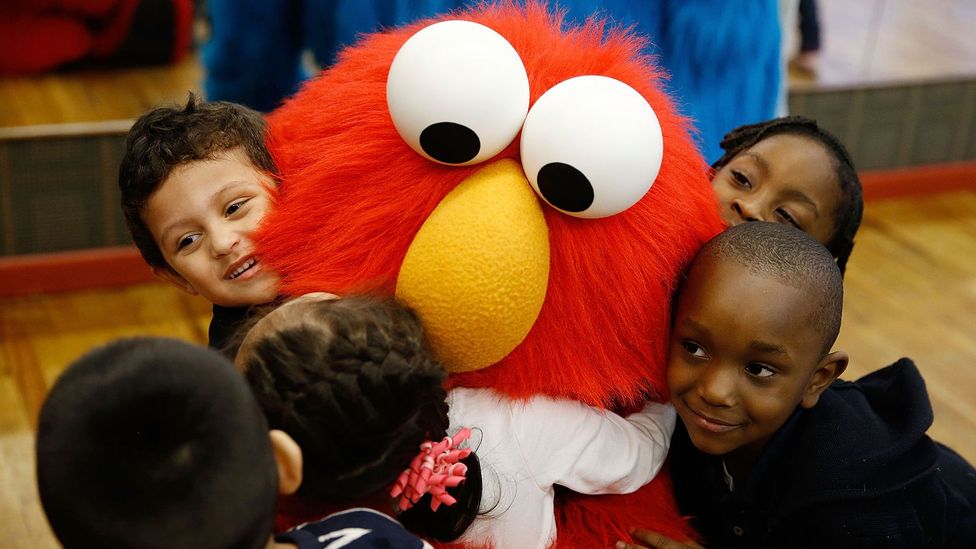
Sesame Street employed developmental psychologists and didactics experts from the outset to help make every episode educational (Credit: Getty Images)
Such direct collaborations between academics and children's TV are non new. Sesame Street, which celebrated its 50th anniversary in 2019, employed developmental psychologists and education experts equally part of the product team from the offset. Co-creator Joan Ganz Cooney idea idiot box might exist used as an educational tool to ameliorate prepare kids for kindergarten.
By Jan 1970, merely a few months afterward it first aired, roughly a third of 2-to-5-twelvemonth-olds in the U.s. regularly watched the show, with upwards of 5 million children tuning in to each episode. And although it was entertaining, every episode was – and still is – planned with specific learning objectives in mind.
"The Sesame mission is to assistance children grow smarter, stronger and kinder," says Rosemarie Truglio, a developmental psychologist who is senior vice president of curriculum and content at Sesame Workshop.
Has it succeeded? By the tardily 1960s, nigh US households owned a television set gear up, just whether they could watch Sesame Street depended on where they lived, because in some areas it was broadcast on Very High Frequency (VHF) channels, in others on Ultra High Frequency (UHF) channels. UHF signals were weaker, and some TV sets couldn't receive them, which meant only effectually two-thirds of Americans had access to Sesame Street.
"Merely the act of being exposed to the show and watching it routinely increased schoolhouse performance among the children who were able to view it," says Phillip Levine, an economist at Wellesley Higher in Massachusetts, citing the results of a written report he and Melissa Kearney at the University of Maryland published. They found that children who watched Sesame Street were more probable to exist academically on rails, and less likely to exist held dorsum, than those who didn't. Crucially, access to a VHF signal wasn't contingent on parents' wealth or education – factors which might have affected children's later schoolhouse performance. In fact, the written report showed that children growing up in "economically disadvantaged" communities benefited the near from watching Sesame Street.
Simply not all television is as concerned with children'southward education.
In the late 2000s, Angeline Lillard, a developmental psychologist at the University of Virginia in Charlottesville, was looking at how children's behaviour might be affected by the ways idiot box characters behaved. Her team had been watching a lot of SpongeBob SquarePants – an American cartoon most a talking yellow body of water sponge living in a pineapple at the bottom of the sea. The show is eclectic, to say the least, something that has helped it attain a cult following with children and adults alike.
"Nosotros were watching a whole lot ofSpongeBob in lab meetings, and I felt I merely couldn't get any work done afterward," Lillard recalls. "I idea: 'If that happens to me afterwards watching it, I wonder what happens to iv-year-olds.'"
This prompted her to start a new study, looking at the affect of television viewing on children's executive office – a set of cognitive abilities that include focusing attention, planning, deferring gratification and managing emotions. Compared to watching a unlike children's drawing, called Caillou (about the everyday life of a four-year-old), or simply doodling on paper with crayons, watchingSouthwardpongeBob impaired four-yr-olds' functioning on various tests, including reciting a list of numbers in reverse, and learning to affect their toes when being instructed to impact their head.
At the fourth dimension, Lillard thought it might have been the fast-paced editing that was to blame. In the SpongeBob clip they used, the scene changed roughly every 11 seconds, whereas in Caillou information technology was every 34 seconds.
Four years later, she published the results of a more thorough follow-upward study. It wasn't the speed of cuts that was problematic, but how much fantastical, physics-defying content they independent.
"Very early in life, if not innately, babies have a folk understanding of having things autumn, or that if something pushes against something else, it is going to fall downward," Lillard explains. But what happens is that a car flies through the air, then it winds upward in outer space, then suddenly they're skiing down a slope, they're under the bounding main, they pour true cat food out of a box and what comes out is far more than could possibly have fitted inside the box… It'southward just one matter later another that can't possibly happen in the real earth. "Our brains aren't set to process all of that," says Lillard. "My clue is that the prefrontal cortex is working hard to figure all that out and and so POOF! It can't do it. Information technology'due south just not realistic."
Lillard stresses that they accept just observed a short-term effect – there'south no direct bear witness to propose that watching highly fantastical content will damage your child in the long run – just children as old as half-dozen were afflicted (they oasis't studied older children).
And it wasn't just SpongeBob. Martha Speaks – a programme most a dog who gains the ability to speak English after drinking some alphabet soup, intended to teach children vocabulary – had a similar result, as did a relatively wearisome-paced cartoon chosen Piffling Einsteins, about 4 pre-schoolers helping a fairy put the Northern Lights dorsum in the sky. Even well-intentioned educational programmes can backlash if their content isn't historic period-appropriate.
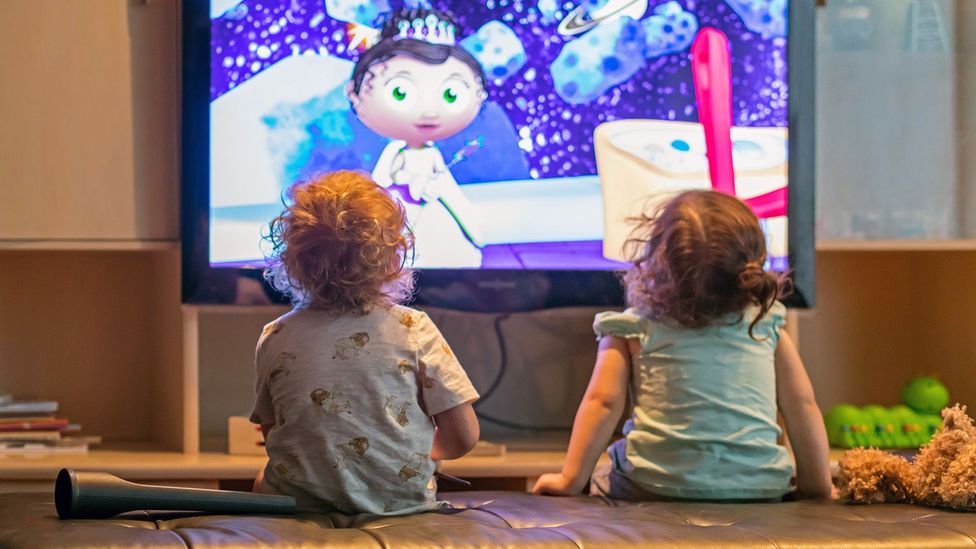
Immature children'south attending is attracted towards very different things compared to adults so television shows utilise this to assistance them follow what is going on (Credit: Alamy)
A series of photographs announced on the screen: two yellow wooden ducks against a white groundwork; two turtles swimming underwater; two panthera leo cubs in the African savannah. Soothing classical music plays in the groundwork.
This is a short prune from Baby Einstein: Numbers Nursery, which aims to introduce infants to the numbers one to v, and I'chiliad watching it with Tim Smith, a developmental psychologist at Birkbeck Babylab in London.
Smith tells me his colleague showed this video to 6-calendar month and 12-month-olds, tracking their gaze to gauge their interest in the images and whether they were looking at both objects, which is obviously important if you're trying to teach the concept of "two". Afterwards watching the clips, they would ask the parents what they thought of them.
The parents would say, "I actually liked the bits with those lion cubs and the turtles, those were really beautiful. My little 1 adored those bits every bit well." Only the researchers noticed that the children seemed uninterested in these scenes.
Smith thinks this is because toddlers' immature visual systems struggle to pick out the creatures from their backgrounds. He shows me a second sequence adult by another colleague, who worked with a television company called Abbey Habitation Media.
A second cutting-out of a lamb spins down onto a obviously green screen while the narrator says: "Information technology's a lamb." The same matter happens twice more than. And so the whole sequence repeatsover again, only this time the narrator says "One, two, three," as each lamb lands. It's ho-hum. It's repetitive. But when the same babies who watched Baby Einstein were shown this, their optics tracked the inflow of each lamb, suggesting that they were engaged and following it.
A memory floods back to me: sitting on the sofa, trying to get my ain young kids to spotter the BBC nature documentary Bluish Planet. At the time, information technology seemed relaxing, educational – surely real porpoises and polar bears are far improve than endless repeats of Peppa Pig? But they seemed completely uninterested. Now I know why.
Smith pulls up a different video. A three-year-old girl in a pink patterned cardigan sits on her mum's lap watching Telly. Another window shows what she'southward looking at: Waybuloo – a British-Canadian children'southward TV series, featuring four CGI animated characters with unnaturally large heads and optics, floating around a fantastical land called Nara.
The girl is hooked up to eye-tracking equipment, and, as the freakishly cute "Piplings" bladder around, her eyes precisely track their movements, confirming that it's these creatures, rather than the mountains or trees in the background, that take engaged her interest. Smith tells me Waybuloo is so effective that Babylabs around the earth now use a clip from information technology, or similar children's cartoons, whenever they need to describe the attention of a child back to what they want them to look at on the screen.
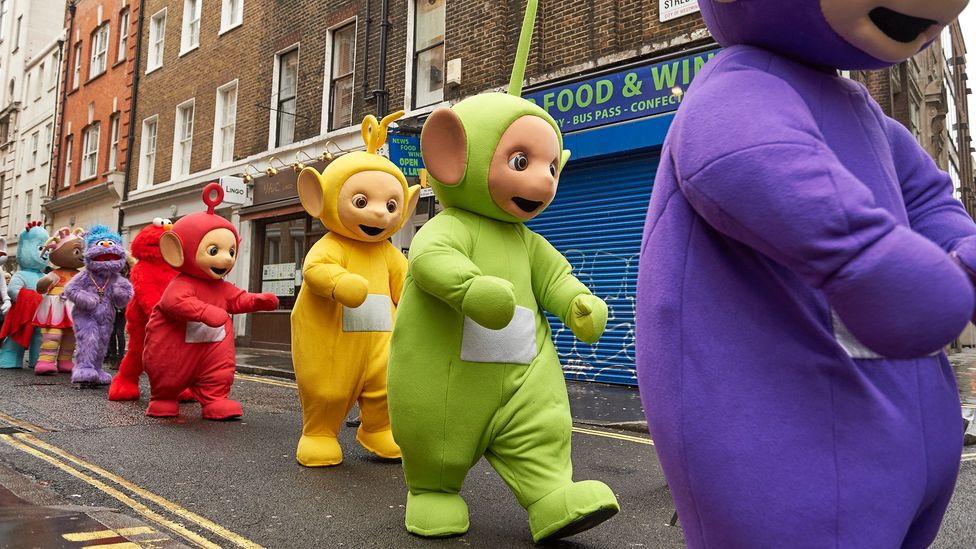
Children'due south TV characters oftentimes accept large, simplified faces and use vivid colours to enable infants' sluggish attention systems to keep up (Credit: Getty Images)
The Goggle box screen flickers. At present the little daughter is watching a film of three women spaced out in a line, each property a brightly coloured brawl. Smith points out the daughter's eye movements. To start with, she looks at each of their faces in turn. Now, as the women begin to trip the light fantastic on the spot, her attention switches between them. Next, the women take information technology in turns to throw their ball in the air or milkshake information technology from side to side, the girl's attention drawn to these bright, moving objects.
I spotter before footage of the same girl when she was only a twelvemonth erstwhile. Her enormous brown optics show a gaze that is more sluggish, less coordinated, drawn less to faces and more towards whatsoever movement on the screen – and to those brightly coloured balls.
It'south a subtle difference, but if you lot want to concenter a young kid's attending towards an object or character, you accept to point all the visual data in a scene towards it or they will struggle to follow the story. That's why children's TV shows have large caricatured faces, oft with things sticking out of their heads. "And then when they move their heads, there's a lot of peripheral motion," says Smith. "There's also lots of luminance and colour contrast that guides their attending to it. You're helping them to detect the thing they're interested in."
In 2014, he published a study showing how closely attention-grabbing features, such as color, brightness and motion, matched the location of the main speaking grapheme in frames from children'southward Goggle box shows, compared with six adult shows. "We wanted to see whether the producers of these children'due south shows accept, through trial and fault, adult techniques that effectively help infants to sympathise and process information," Smith was quoted as saying at the fourth dimension.
They had. Paring downward the action enables infants' sluggish attentional and visual systems to keep up. And characters' eyes tend to exist very clearly marked, the outlines of their faces oft set against white, or compatible-coloured backgrounds, making them stand out even more.
Information technology means that even with a very primitive visual system, you're all the same able to very quickly identify that chief speaking character. This makes it easier for children to follow the story and potentially acquire from it.
Andrew Davenport – the producer of Teletubbies and Moon and Me – studied speech therapy at university, but his real passion was drama.
Upon graduating, he and a friend set up a theatre production company, and information technology was through this that he landed a job as a writer and puppeteer on a Ragdoll Productions bear witness chosen Tots TV. The bear witness, which featured three ragdoll friends, their pet donkey and a mischievous canis familiaris, won two BAFTA awards, finding audiences in the UK, US, Central and Due south America. But it was naught compared to what Davenport did next.
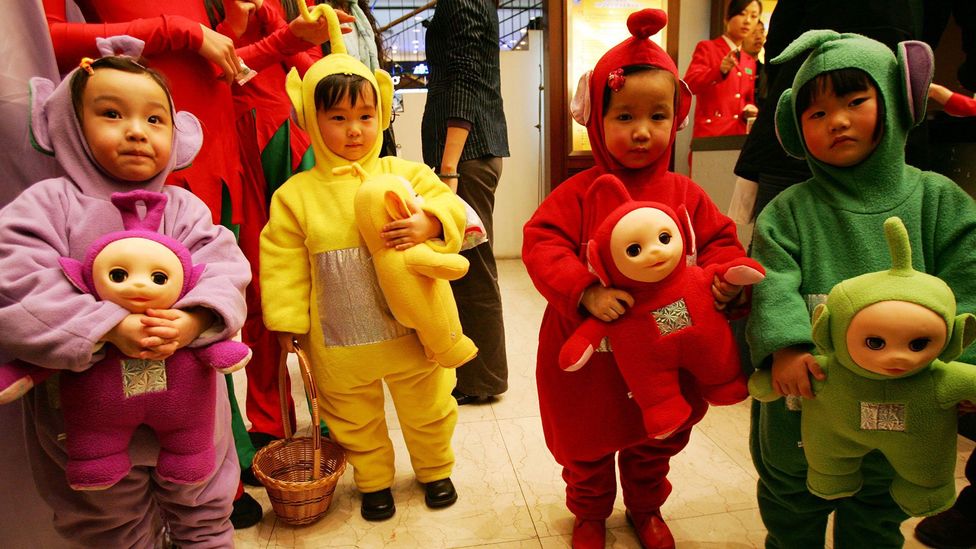
The Teletubbies obtained worldwide appeal peradventure considering information technology was specifically designed for one and two yr olds (Credit: Getty Images)
Teletubbies was the Idiot box equivalent of a Hollywood blockbuster, going on to air in over 120 territories in 45 different languages. Tinky Winky, Dipsy, Laa-Laa and Po were inspired by a trip to the Smithsonian Institution in Washington with Anne Wood, founder and artistic director at Ragdoll. They wandered into an exhibition about infinite and Davenport said, "Isn't it weird how they put all this technology into the spacesuits, and when yous see them walking about in them, they expect equally much similar babies in nappies every bit annihilation."
The Teletubbies were conceived as technological babies, set in a technological superdome. Even the windmill on the colina is a nod to one of the start pieces of technology children run into: a pinwheel on their pram. Their bodies were painted bright fluorescent colours, because that seemed to fit with the technology theme, as did putting the Television receiver screens on their stomachs – TVs that showed videos of children doing simple activities out in the existent world.
"For me, Teletubbies is entirely effectually that early phase of life when the child is coming to grips with their own torso and their own physicality: walking, talking, running, falling over – all of the things that the Teletubbies did," says Davenport. The green-hilled fix was designed to accentuate the depth of the concrete space they inhabited, and much of the show simply involved the Teletubbies coming and going and popping upward and down, playing with those physical concepts.
Some adults, notwithstanding, didn't get it. The testify was defendant of "dumbing down" children's TV and criticised for its abiding repetition, poor plots and lack of sense of place. Merely that was exactly the point. Teletubbies was possibly the get-go TV prove specifically designed for 1-to-ii-year-olds. One Norwegian Television executive has described it as "the near market-oriented children's program I've e'er seen".
Davenport and Wood had learned the visual equivalent of infant talk. If the Teletubbies are weird, it'southward because – visually and developmentally – so are infants.
For Wood, the blueprint of shows similar Teletubbies is intuition combined with years of trial and error. "I remember the but skill I accept, if I have one, is being able to watch a screen similar a three-yr-old might. It is about knowing when to suspension, how long to interruption for, how to brand that comic, how to apply anticipation."
Although children alive in the same world as usa, they perceive it differently. A footling girl with a babe brother might posit that all babies are born boys, and then plough into girls, for instance. Or that houses fall downward to Earth and then walk into position, using their legs. "Yous can come across how young children will often say things that we think are funny because their perception is that X is the example, when in fact Y is the case. That difference needs to be respected, but every bit it can be the stuff of content," says Wood.
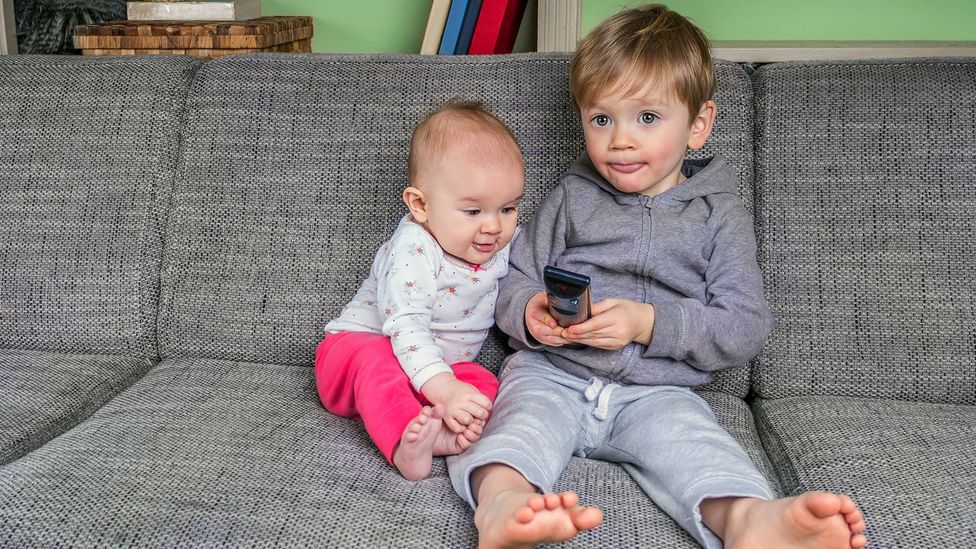
Engaging with what children are watching on telly may be a good way for parents to aid their youngsters learn more than (Credit: Alamy)
Often, her programmes are designed as a chat between the television receiver and the children watching it. "When people objected to Teletubbies, we used to say: 'Expect, Teletubbies empathize babies, and babies sympathise Teletubbies. If you're watching Teletubbies without a child, yous are only getting one half of the chat.'"
She cites the kickoff of the testify, where a boat goes out of frame, then comes dorsum in, then goes out of frame again. "That sequence is well-nigh playing a peekaboo game with a very young kid: Where's the gunkhole gone? Hither it is, coming back again." A recent survey found that a game of peekaboo is the surest way to make a baby express mirth.
After the success of Teletubbies, Davenport and Wood moved on to In the Night Garden, which Davenport describes as a "contemporary nursery rhyme" aimed at two-to-iii-year-olds. "It's that phase where the child has come to grips with the physicality of the world and is now fascinated with the idea of turning what information technology knows on its head in an abstract manner – the time when nursery rhymes, linguistic communication play, symbolic play, toy play start to become the thing." Each character is designed to stand solitary, just like Humpty Dumpty or The Quondam Adult female Who Lived in a Shoe exercise in a volume of nursery rhymes.
The central character, Iggle Piggle, represents a kind of "every-child", who lollops around trying to brand sense of it all. Davenport says he was inspired past a little daughter who used to say "Iggle Piggle Iggle Piggle Iggle Piggle" whenever she was excited. There'due south also Makka Pakka, a biscuit, round-bodied creature, with a penchant for collecting piles of rocks and washing things with a sponge.
Davenport is fascinated past the thought of accessing his audience through their ain preoccupations and interests. Stone-collecting was a childhood hobby of his, while the obsessive washing is not about cleanliness but engaging with an activity that many immature children find challenging: washing their faces and getting ready for bed. "The idea is that you can create these little nuggets of activity, routine, rhyme or song which become something that parents and children tin can share together to become through something that might exist tricky or difficult," he explains.
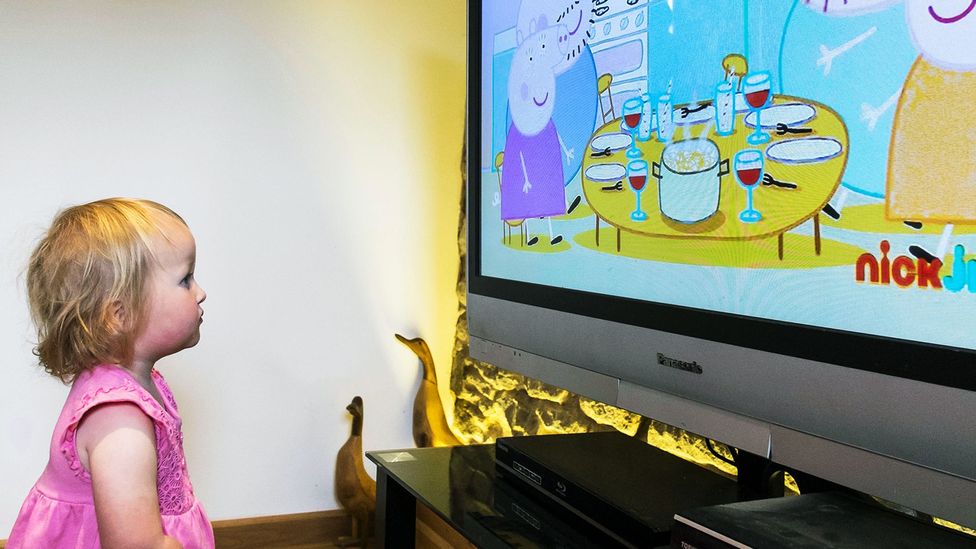
Many parents worry about the television set their children are watching but some studies prove that the correct kind of programming can take positive effects (Credit: Alamy)
I remember In the Night Garden's opening sequence – which involves a rhyme about a footling gunkhole no bigger than your hand circling circular and effectually in the ocean, while an adult traces circles on a child'southward palm. It was a failsafe way to put my son to slumber. When I tell him, Davenport sounds genuinely moved. "When these things are working, they do become components of the relationship between the parent and the child".
Davenport has seen his godson using Makka Pakka'south song as a way to wash his pilus and face. "When yous find that something is useful, that's patently incredibly satisfying and rewarding," he says.
This is what led him to approach the University of Sheffield during the development of Moon and Me. He'd read a study where 2 groups of children were taught a lesson including either standard materials or some involving the Teletubbies. Those working with the Teletubbies material seemed far more than engaged than in their normal lessons – in i example a child who barely spoke and hardly took office in class activities returned their completed job asking for another one.
"If you arroyo children through their own culture, rather than imposing your culture on them, they are much more motivated and more interested," says Davenport.
Having read well-nigh the work with Teletubbies, and becoming intrigued by the idea of child culture, he approached the researchers about doing a report to learn more almost how gimmicky children play with toy houses. The result was his collaboration with Dylan Yamada-Rice, now at the Royal College of Art in London.
Moon and Me is aimed at a broader historic period range than either Teletubbies or Dark Garden. Information technology'southward a tale about a toy house coming to life at night, of the sort that were popular in the 1940s and 50s.
"At that place is still a full general supposition that stuff can exist made for adults and but dumbed down for kids without looking specifically at the needs of that immature audience," she says. But if y'all want them to learn anything from it, yous demand to find ways of engaging that immature audience.
"If yous can't believe in the depth of the character and that ane grapheme deeply cares virtually some other character, so yous're not going to exist very effective in maintaining children's interest. And if you don't believe in that character, then y'all're not going to care that they are writing a letter to the moon."
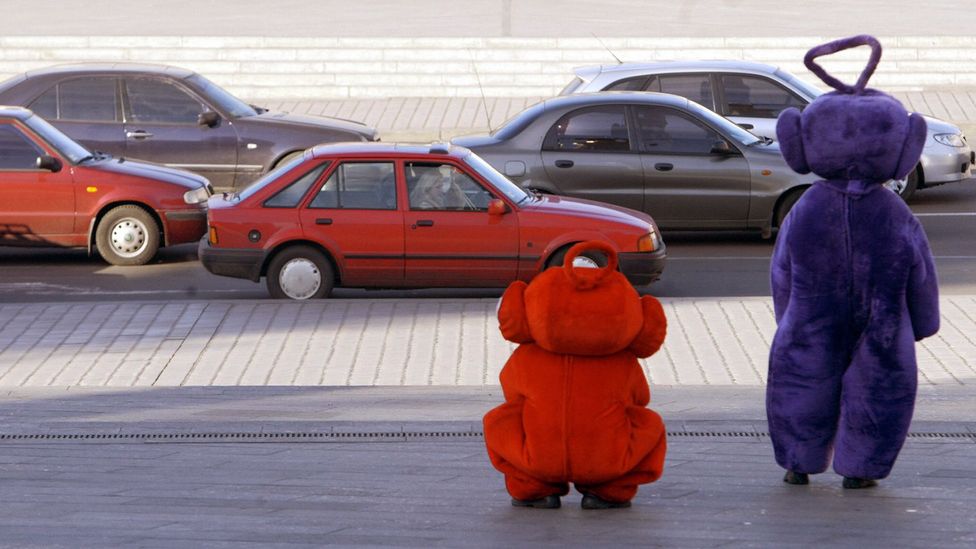
Children who were taught lessons using materials involving the Teletubbies were far more engaged than those without according to one study (Credit: Getty Images)
Yamada-Rice joined together two large toy houses from the section store John Lewis, and fitted them with tiny cameras, pointed not at the children but at the toys within the houses. They so assembled a grouping of one-to-5-year-olds from different cultural backgrounds and set them loose on the toys, recording how the toys were moved, what the children were saying as they played with the characters and what voices they were giving them.
I thing they noticed was the children's preoccupation with transitions: going up and down the stairs; in and out through the front door; into bed for sleep and dorsum out over again; and the importance of sitting down for tea. Another ascertainment was how the children often had multiple scenarios occurring on different floors of the houses. "Maintaining them all was a bit similar spinning plates," says Davenport. "And so, a shot which recurs a lot in Moon and Me is of the whole house with all three floors exposed, then you can see the characters on the dissimilar floors and stairs".
I sit down downwards with Tim Smith and watch an episode. At that place's the narrator tucking the diverse characters into bed on the different floors of the house. There's Moon Baby ringing the front doorbell and Pepi Nana letting him in. In that location'south a shot of Pepi Nana walking down every stride of a staircase.
Smith points out the moonlight lighting up Pepi Nana's face as she sits up in bed; the employ of noises, such every bit Colly Wobble's tinkling bell, to cue viewers' attention and prompt them to seek him out; the developed narrator asking "What'southward next?" every bit Mr Onions lays the table, then a subtle flash of move nigh the cups. All of these, he says, help engage the child'south attention and assistance them to follow the story.

Young children can become transfixed by boob tube programmes that adults find utterly baffling (Credit: Alamy)
In that location are subtle lessons woven into the fabric of Moon and Me, such as the fine art of structuring a letter, and telling a story – core principles of early-years education – or Pepi Nana climbing into a tub, which rolls away, and then popping out of it once more, which helps teach about object permanence. Davenport tells me his shows aren't intended to be "educational". His audience, he says, is pre-educational. He strives to provide what he describes as "the "unfatiguable" practice of mind".
Here's the general rule: earlier the age of ii, kids won't become much out of Tv set – unless an adult is sitting with them, helping them to understand it.
"The way nosotros tend to make television for kids is to create stories through a narrative that unfolds over time with characters interacting," says Heather Kirkorian, a developmental psychologist at the University of Wisconsin in Madison. "That kind of traditional narrative format probably won't piece of work very well for kids under two." If they watch too much TV, this could even undermine their development by discouraging them from interacting with the real world.
From age two or three until they are v, children can follow simple plots, but not complex moral lessons, such equally a bully getting his or her come-uppance at the terminate. "Kids at that age are non really able to be like, 'Oh, here's this dandy, and he's and then mean, and I don't desire to be like him because I'm learning that that's bad,'" says Polly Conway, senior Telly editor at Mutual Sense Media, an American arrangement which tries to aid parents navigate this complex maze. Rather, these young children may try to emulate the bad behaviour. "What they demand to see is someone like Daniel Tiger [a pop American-Canadian cartoon character] only going through this 24-hour interval and learning to necktie his shoes, peradventure saying hullo to his grandad."
Schoolhouse-age children tin can cope with more complex plots and moral lessons. "Certainly, the eight-to-12 historic period grouping are able to encounter that negative behaviour and understand that the message is 'Don't do this negative behaviour'," says Kirkorian. Nevertheless, they may all the same struggle with jumps in fourth dimension, such every bit flashbacks. In fact, it's not until around age 12 that children begin to accept adult-like comprehension of what they run across on the screen. Her inquiry suggests that toddlers may gain more from simple interactive apps, like games or even video chats, than from Television shows.
"All boob tube content is teaching something. The question is what is it teaching?" Joan Ganz Cooney, the co-creator of Sesame Street, used to say. A lot of content still portrays unhelpful stereotypes well-nigh, say, what girls and boys tin can do, or features violence. "Information technology's very dissimilar from an adult brain where y'all can say, all right, this is but one-act and this is fun," says Rosemarie Truglio of the Sesame Foundation.
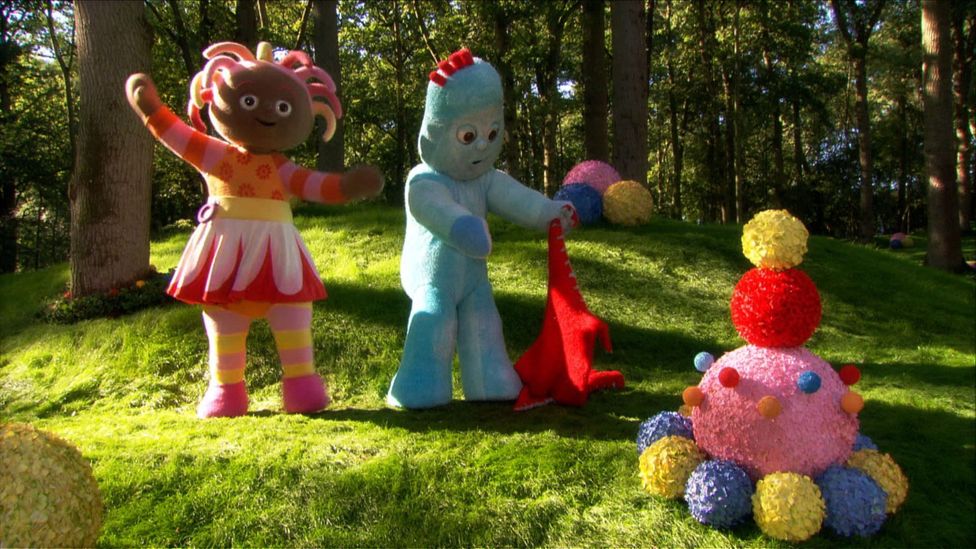
The characters from In the Night Garden are intended to accept the aforementioned preoccupations and interests equally the young audience who watch them (Credit: BBC)
Truglio says the best style for kids to watch the programme – whatever programme – is with a caregiver. That way you lot tin reinforce the educational messages they are getting from the Telly. Co-watching with older kids can too be tin be useful, because if y'all spot them enjoying something with dubious morals or stereotypes, and then you can open up a discussion about it.
A lot of studies have shown that standard adult-focused form volition atomic number 82 to very poor transference of knowledge to the real world, Tim Smith tells me. Only you tin overcome that, either by having the prove engage with the immature children, for example past asking them questions, or, more importantly, by having another person there. Children can be highly engaged and cognitively active, only their attention is e'er express, says Smith. He suggests occasionally pressing intermission, giving children the time to engage and discussing what they're watching.
As a female parent of two, all of this sounds good in principle. But sometimes we just want some peace and quiet. Sometimes nosotros've got stuff to practise. Sometimes nosotros've been playing with them for three hours and need a suspension.
When I was young, kids' Television receiver was but available for a few hours a twenty-four hour period. Then along came Nickelodeon and the Disney Channel. Now it's YouTube and Netflix on need.
I'm reassured that occasionally employing Iggle Piggle or Moon Baby is unlikely to be harmful. Merely I'm besides inspired – to not necessarily switch off when the Boob tube or iPad is switched on. Because with a little more attempt from me, it can be something even meliorate: a weird globe that nosotros tin explore together.
* This is an edited version of an commodity that was first published byWellcome on Mosaic and is republished hither under a Artistic Commons licence.
--
Join one million Future fans by liking us on Facebook , or follow us on Twitter or Instagram .
If y'all liked this story, sign up for the weekly bbc.com features newsletter , called "The Essential Listing". A handpicked selection of stories from BBC Future, Civilization, Worklife, and Travel, delivered to your inbox every Friday.
Source: https://www.bbc.com/future/article/20191206-why-children-find-weird-television-so-mesmerising
0 Response to "Kids Show Wil Pick Yoi Up Again"
Postar um comentário